When you find yourself in the wilderness, the knowledge of how to make survival weapons can be the difference between thriving and merely surviving.
To make survival weapons in the wilderness, gather natural materials like wood, stone, and plant fibers to craft tools such as spears, bows, and knives.
Dive into our step-by-step guides to learn the ins and outs of creating your own arsenal from the natural world around you. From identifying the right materials to mastering the art of weapon crafting, we’ll ensure you’re prepared to face the wilderness with confidence and skill.
Why Do You Need Survival Weapons?
Survival weapons are not just tools; they are your lifeline in the wilderness. They protect you from potential threats, whether it’s a wild animal or an unforeseen danger. Having a weapon not only boosts your confidence but also significantly increases your chances of survival. It’s about self-defense and being prepared, knowing you can protect yourself and secure food when necessary.

Crafting these weapons also instills a sense of self-reliance. With the right skills, you can turn natural resources into effective tools. Whether it’s a spear for fishing or a slingshot for small game, these weapons ensure you’re not just a visitor in the wilderness but a part of it, capable of adapting and thriving.
The true art of survival lies not in possessing the tools but in the ability to create them from what nature provides. It’s about seeing the potential in a branch, a stone, or a piece of vine. Crafting your survival weaponry requires patience, precision, and creativity, turning the natural environment into your ally.
This mastery doesn’t come overnight. It requires practice, a deep understanding of the materials at hand, and the methods to transform them into functional tools. By learning these skills, you ensure that no matter where you are, you have the means to protect yourself, hunt, and survive. This knowledge empowers you, making you more than just a survivor—you become a warrior of the wild.
Finding the Right Materials for Wilderness Weapons
To craft effective survival weapons, you must first find the right materials. Look for sturdy branches for the frame of weapons like bows or slingshots. Stones with sharp edges are ideal for cutting tools or arrowheads. Understanding the properties of these materials—such as flexibility, strength, and sharpness—is crucial in determining their suitability for different types of weapons.
Exploring your surroundings with a keen eye will reveal a wealth of resources. Each environment, whether forest, desert, or mountainside, offers unique materials. Learning to identify and utilize these resources is a vital skill, ensuring you’re never without the means to defend yourself or hunt, no matter where you find yourself.
Take note that not all natural materials are created equal when it comes to crafting survival weapons.
The best resources combine durability with ease of use. For instance, hardwoods like hickory or oak make excellent bows and spear shafts due to their strength and flexibility. Stones like flint or obsidian are preferred for sharp edges, ideal for cutting tools and arrowheads.
Understanding the properties of these materials allows you to make informed decisions about which to use for different survival weapons. Experimenting with various resources also helps you discover what works best in different situations. With time, you’ll develop a keen sense for selecting the most effective materials, ensuring your survival tools are as reliable and efficient as possible.
Here’s a table summarizing your best options when picking the right materials for your survival weapon:
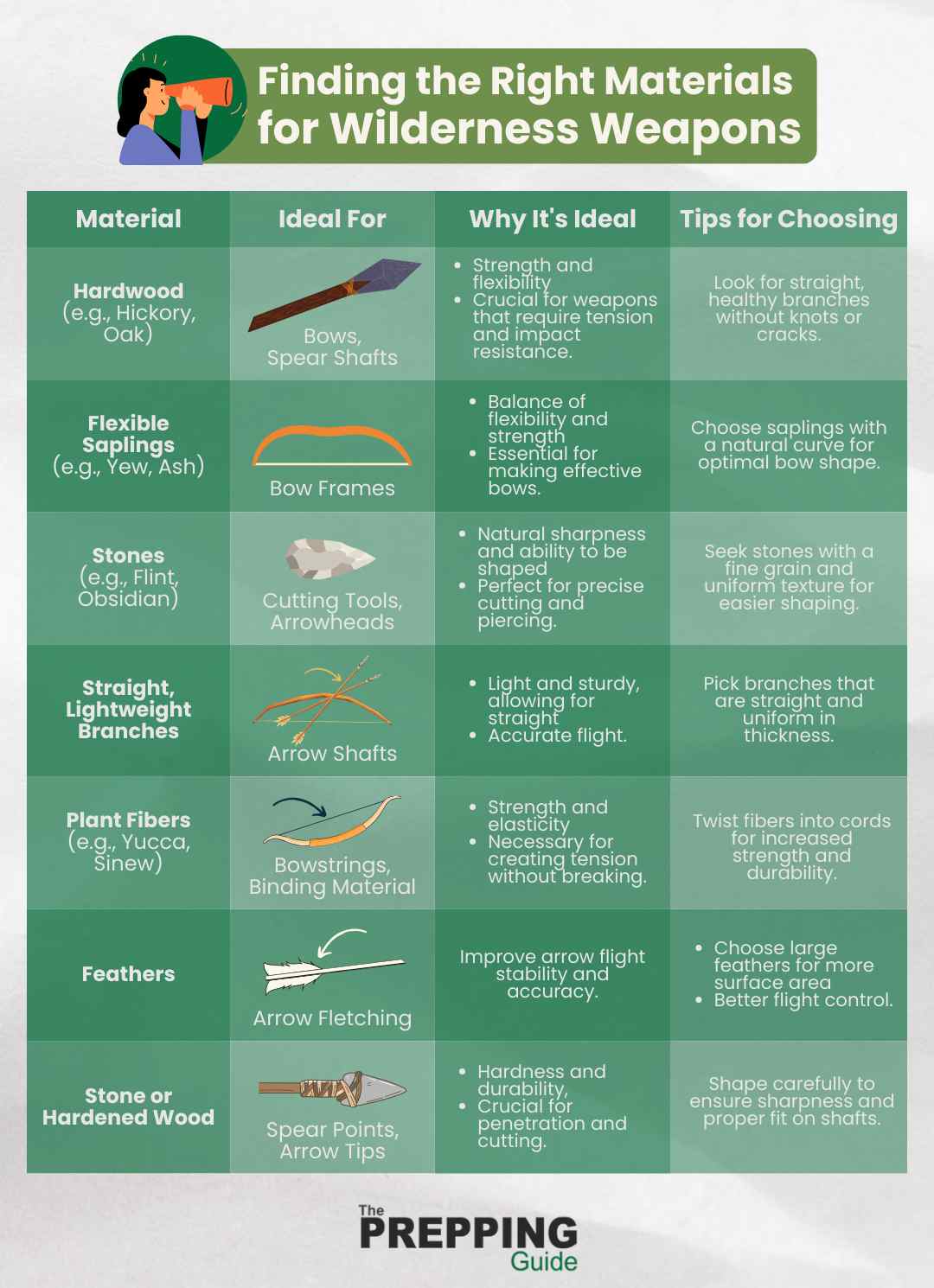
Crafting Your Arsenal: Step-by-Step Guides
Once you’ve gathered the right materials, it’s time to transform them into survival weapons. Crafting your arsenal is not just about making tools; it’s about equipping yourself with the means to live another day. Each weapon you create is a step towards mastering the wilderness, providing you with food, protection, and confidence.
DIY Slingshot
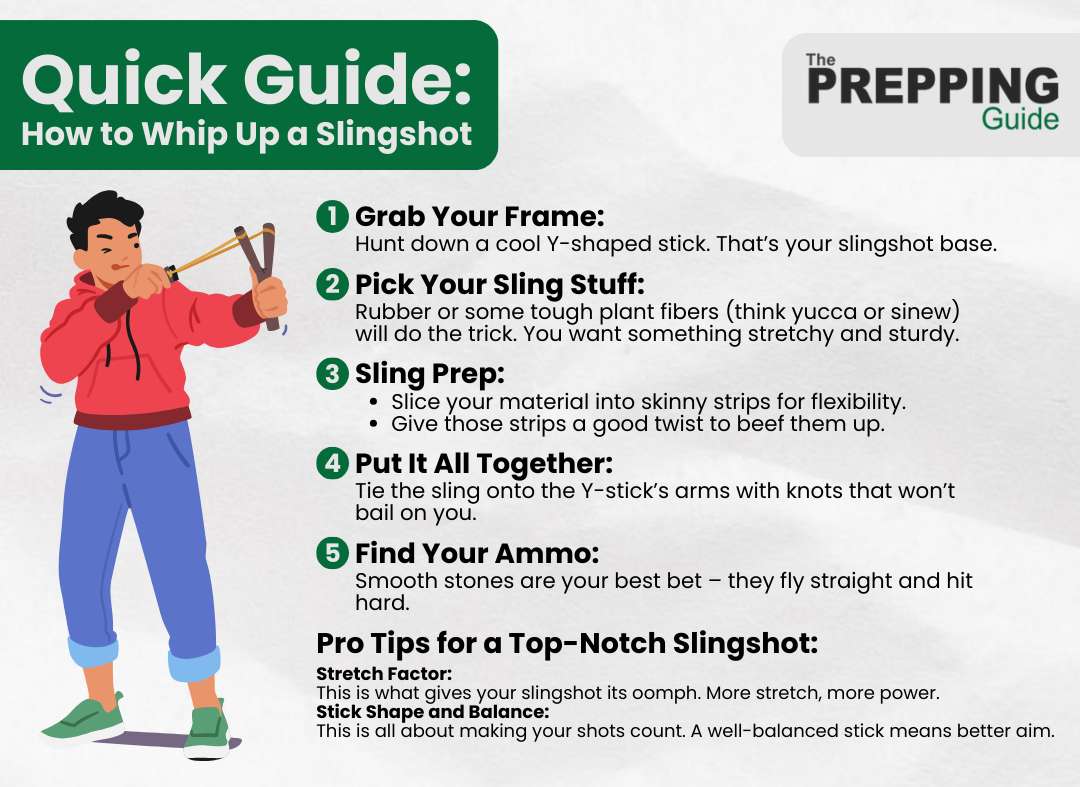
A slingshot is a simple yet effective weapon for hunting small game. Start by finding a Y-shaped branch, which will serve as the frame. For the sling, natural rubber or plant fibers like yucca or sinew work well. Strip the fiber into thin strands, twist them together for strength, and attach them to the Y-branch using a secure knot at each end. The center of the sling will hold your projectile, ideally a smooth stone.
Crafting a slingshot is as much about precision as it is about materials. The elasticity of the rubber or fibers determines the slingshot’s power, while the shape and balance of the Y-branch affect its accuracy. With practice, you’ll learn to choose the right materials and design for your needs, making the slingshot a reliable tool in your survival arsenal.
Primitive Knives and Axes
Knives and axes are indispensable in the wilderness for cutting, chopping, and carving. To make a knife, find a stone like obsidian or flint with a sharp edge. If the stone isn’t sharp enough, you can shape it by striking it with a harder stone to flake off pieces until a sharp edge is formed. For the handle, use a sturdy stick or branch, securing the stone to it with vine or sinew.
Axes require a larger stone and a longer handle for effective chopping. The process is similar to making a knife but requires a bigger, flat stone. The stone is attached to the center of a branch, split at one end, to create a head. Secure it tightly with natural fibers. These tools are not only functional but also connect you to the ancient art of tool-making.
Spears and Fish Spears
Spears are versatile weapons for hunting and fishing. Start with a long, straight branch for the shaft. For a hunting spear, sharpen one end into a point. Fire-hardening the point by gently roasting it over flames can increase its durability and lethality. For fish spears, split the shaft’s end into multiple prongs, sharpen each prong, and fire-harden them as well.
The key to a successful spear is balance and precision. The shaft must be straight and light enough to throw or thrust with accuracy but sturdy enough to withstand impact. Experimenting with different woods and designs will help you create the perfect spear for your needs.
Throwing Sticks and Atlatls
Throwing sticks and atlatls enhance your range and power when hunting small game and fish. A throwing stick is simply a curved branch, balanced and smoothed for aerodynamic flight. The atlatl, an ancient weapon, uses a shaft with a hook to propel a dart or spear with greater force than by arm strength alone. Create the dart from a straight, lightweight branch, and fashion the atlatl from a longer piece of wood with a notch to hold the dart.
Using these tools requires practice to master the technique. The throwing stick’s curve and weight distribution must be perfected for effective use, while the atlatl’s length and the angle of the hook are crucial for maximizing propulsion and accuracy.
Bows and Arrows
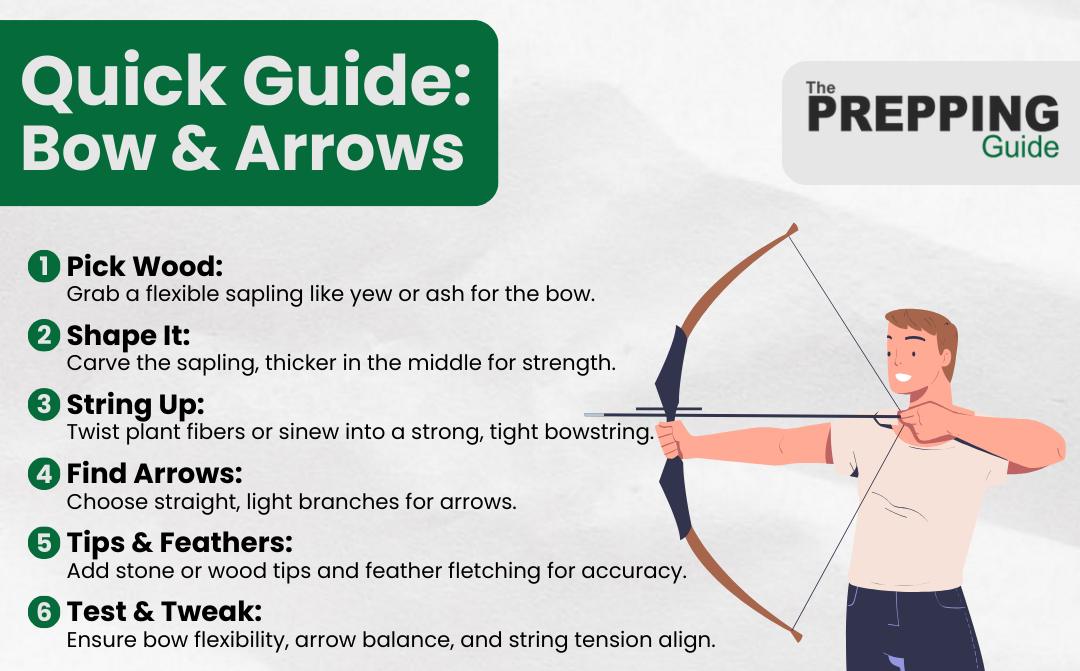
Making a bow and arrows is a challenging but rewarding task. Choose a flexible sapling for the bow, such as yew or ash, and shape it with a knife, leaving the center thicker for strength. For the bowstring, use twisted plant fibers or sinew, ensuring it’s taut enough to bend the bow without breaking. Arrows can be made from straight, lightweight branches, with stone or hardened wood tips and feathers or leaves for fletching.
Accuracy with a bow and arrow comes from the bow’s design and the archer’s skill. The bow’s flexibility, the arrow’s balance, and the string’s tension must all work together harmoniously. With practice, you’ll find this ancient weapon not only effective for hunting but also a profound connection to the land and its resources.
Advanced Survival Weapons
As you become more proficient in crafting basic survival weapons, you might find yourself curious about more advanced or unconventional options. These weapons can offer advantages in specific situations, whether for defense or hunting. Learning to make and use them can expand your survival skills and adaptability in the wilderness.
Bullwhips and Throwing Stars
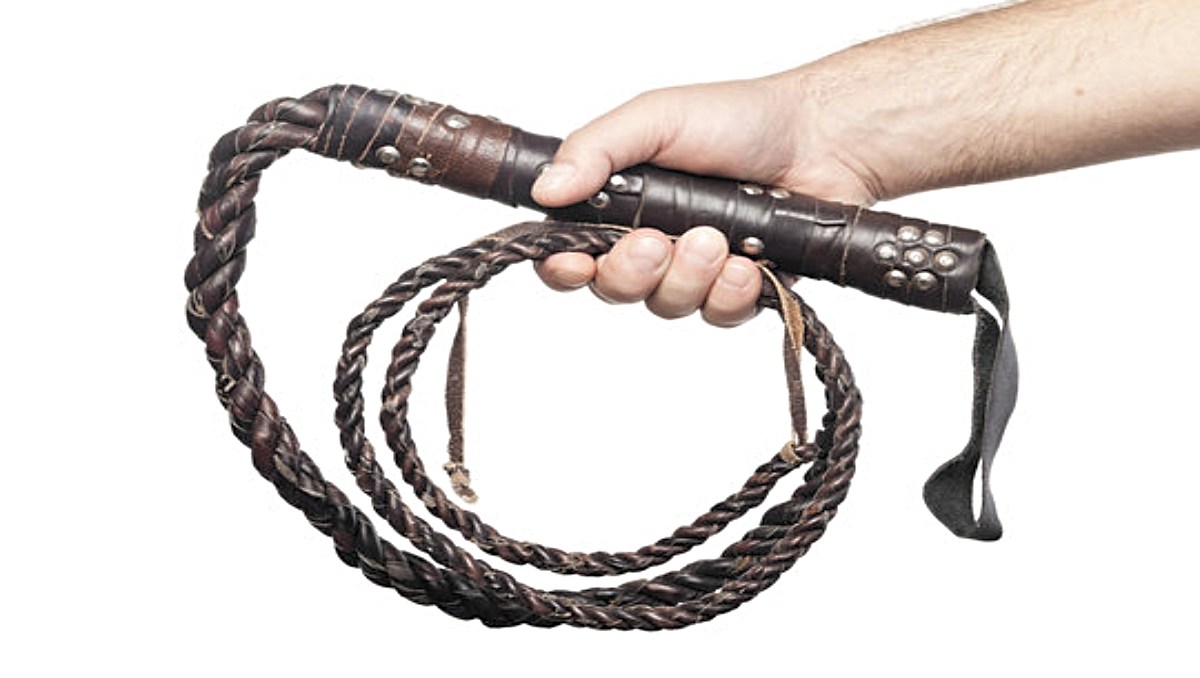
Bullwhips and throwing stars might seem like the stuff of adventure stories, but they can have practical applications in survival scenarios. A bullwhip, made from braided plant fibers or strips of hide, can be used to hunt small game or as a deterrent against predators. The technique of wielding a bullwhip effectively requires practice, particularly in mastering the precise motion needed to generate the characteristic snap.
Throwing stars, although more complex to craft, can be fashioned from flat stones or metal pieces, if available. The edges must be carefully sharpened, and while they require skill to use effectively, they can be a silent option for hunting or defense. These unconventional weapons highlight the importance of creativity and skill development in survival situations.
Blunt Force Weapons and War Hammers
In situations where you’re facing larger predators or need to break through obstacles, blunt force weapons like clubs, maces, and war hammers can be invaluable. These weapons rely on heavy materials for the head, such as stones or dense wood, attached to a sturdy handle. The key is balancing weight for forceful impact without making the weapon unwieldy.
Crafting these weapons involves selecting the right materials and securely attaching the head to the handle, often with strips of hide or tightly wound cordage. These tools are not only effective for defense but can also be used for breaking ice, cracking nuts, or any situation where brute force is necessary. As with all weapons, practice is key to handling them effectively and safely.
Maintaining Your Wilderness Weapons: Tips and Tricks
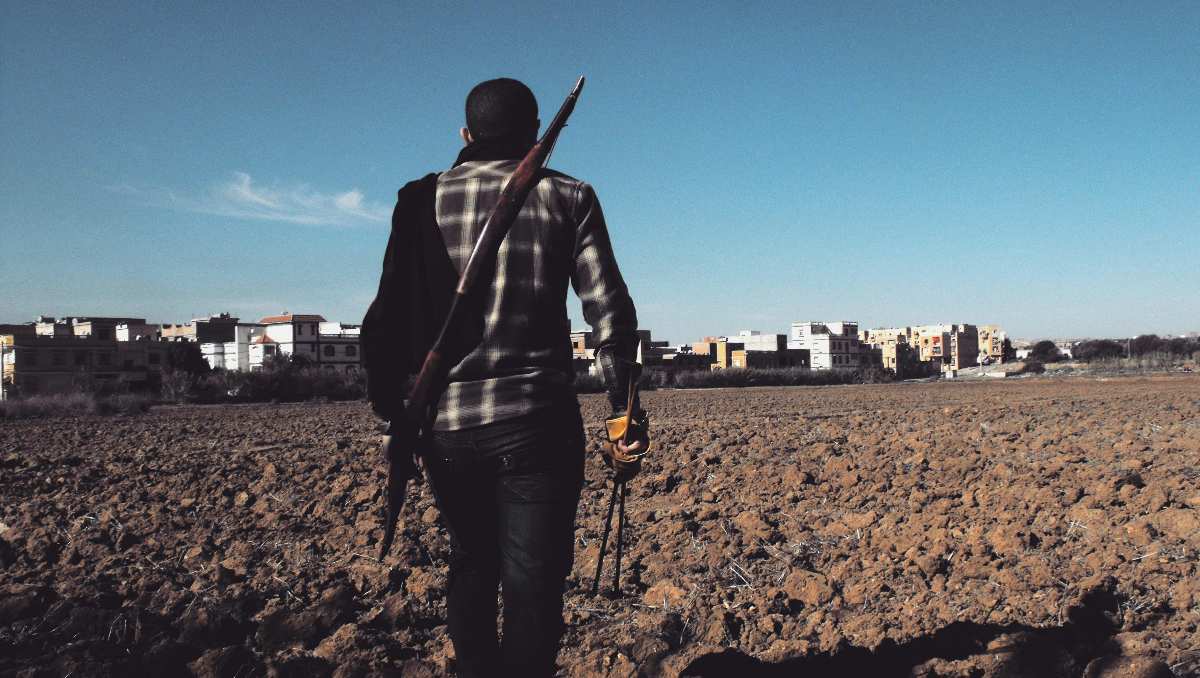
Routine checks for wear and damage, along with timely repairs, can prevent failure at critical moments. For edged tools, such as knives or spears, regular sharpening ensures they remain effective for cutting and hunting tasks. Other weapons, like bows and arrows, require inspection for cracks or weaknesses and adjustments to maintain tension and accuracy.
Beyond maintenance, continuous improvement of your skills is vital. Practice using your weapons in various conditions to better understand their capabilities and limitations. This practice not only sharpens your skills but also deepens your connection to the tools you rely on for survival. It’s a process of learning and growth that enhances both your confidence and competence in the wilderness.
Final Thoughts
Survival in the wilderness is about more than just enduring; it’s about thriving with respect for the natural world. The weapons you craft are tools of survival, imbued with the knowledge and respect you hold for the environment.
By balancing ethical considerations with the need for safety, maintaining your tools diligently, and continuously honing your skills, you prepare yourself for whatever challenges the wilderness may present. Remember, the greatest survival tool you possess is your knowledge and how you choose to apply it.
